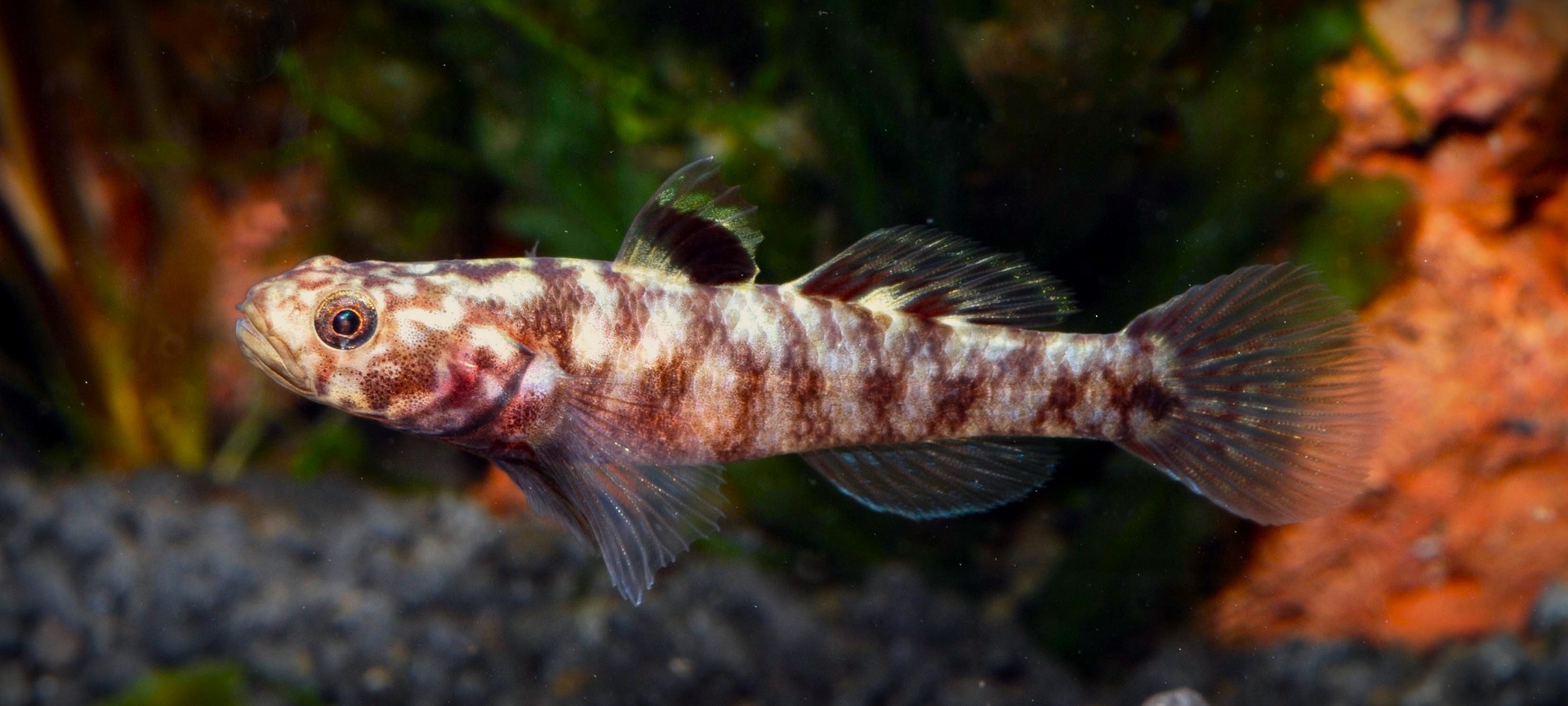The Indonesian island of Sulawesi is very rich in endemic freshwater fauna. It is part of the Wallacea, a biodiversity hotspot between the Australian and Asian continental shelves. Wallacea is separated from the surrounding islands by deep straits, but this separation does not mean that there are few species – quite the contrary. The isolation of Sulawesi and especially its ancient lakes results in a very interesting species radiation. While aquarists are familiar with the amazing diversity of Sulawesi shrimps (Caridina spp.) and snails (Tylomelania spp.), there is also a unique and rich diversity of fish.
There are about 70 endemic species of freshwater fish in Sulawesi. Most of them belong to these families:
- Telmatherinidae (sailfin silversides)
- Adrianichthyidae (ricefishes)
- Zenarchopteridae (viviparous halfbeaks)
- Gobiidae (gobies)
Let's take a brief look at each of these groups from the perspective of an aquarium enthusiast or conservation breeding project participant.
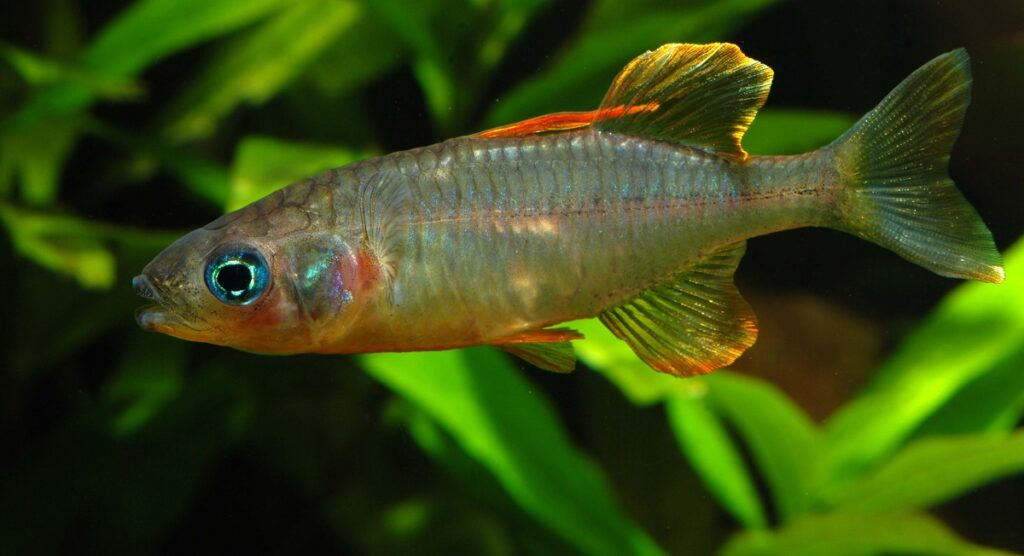
Sailfin silversides (Telmatherinidae)
17 species endemic in Sulawesi (the whole family is restricted to Sulawesi with a single exception)
Short description: Small atherinid fish with sexual dimorphism and polychromatism (same species can have different colour morphs). Their name derives from the shape of the first dorsal fin in some species which has a sail-like appearance and can be colourful, but the overall appearance of these fish is silvery with yellow, blue or black in males. Fast moving, active, with interesting courtship. Includes genus Telmatherina, Marosatherina, Paratherina, Tominanga.
Distribution: Only one species lives in rivers in SW Sulawesi (Marosatherina ladigesi), other sailfin silversides are endemic to the Malili Lakes and connecting rivers. Vast majority is lacustrine, i.e. inhabits lakes.
Species kept in aquaria: Marosatherina ladigesi (common), Telmatherina cf. bonti (very rarely) – this is the only riverine Telmatherina with several populations known.
IUCN Red list evaluation: critically endangered: Paratherina labiosa (endemic to Lake Lontoa); endangered: Telmatherina bonti, T. wahjui; vulnerable: Marosatherina ladigesi; near threatened: Paratherina cyanea, P. wolterecki, P. striata, Telmatherina opudi, T. sarasinorum, T. obscura, T. celebensis, T. antoniae, T. abendanoni, T. prograntha, Tominanga aurea, T. sanguicauda; data deficient: Telmatherina albolabiosa
Current status and threats: Largely unknown. Systematics, taxonomy, evolution and biology of this group still remains unclear and more studies are needed and in progress. Malili lakes are highly threatened due to water quality issues and most importantly due to the continuous spreading of invasive flowerhorn fish, but there are virtually no ex situ insurance populations of sailfin silversides.
Sulawesi Keepers note: There is ongoing research of sailfin silversides conducted mainly by Museum Koenig (LIB, Bonn, Germany) and University of Antwerp (Belgium) together with Indonesian research partners. It would be great to find out more about how these fish live in the wild, and above all to map their distribution and status. All endangered species should have ex situ insurance populations established.
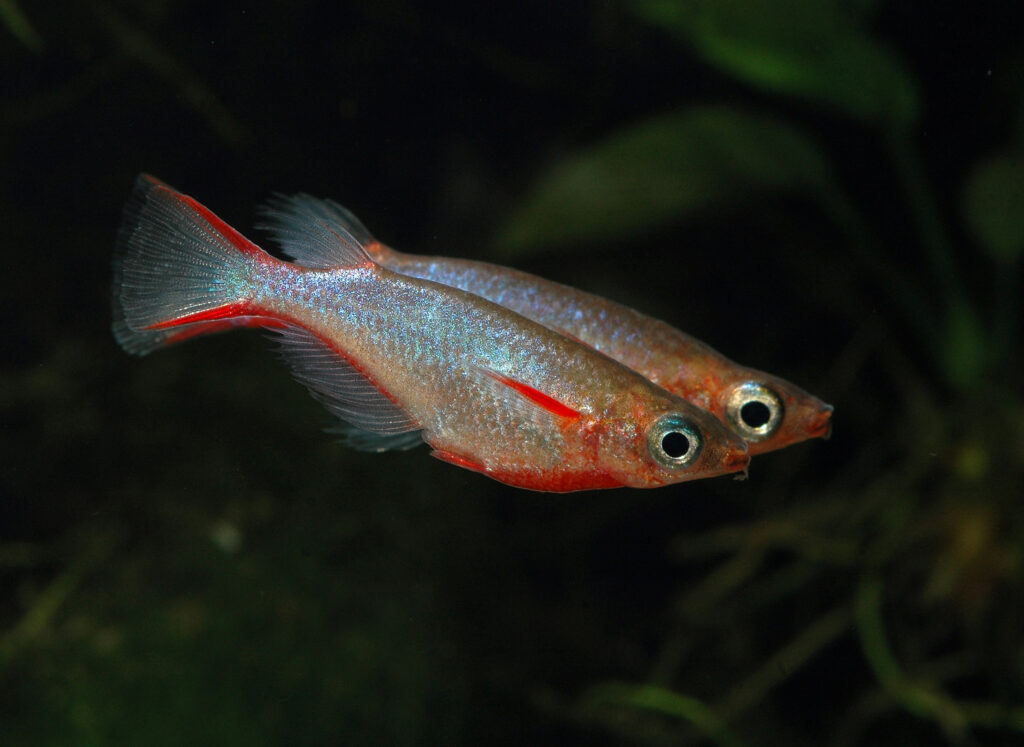
Ricefishes (Adrianichthyidae)
23 species of ricefish are known from Sulawesi, 19 are endemic
Short description: Most species are small, silvery fish. Males are sometimes colourful and can be recognized by prolonged fin rays. Two reproductive strategies are known: 1) so called transfer-brooders deposit their eggs on substrate such as plants; 2) in pelvic brooders, females carry the clutch of eggs until they hatch.
Distribution: Riverine or more often endemic to Poso Lake, Malili Lakes or other smaller lakes.
Species kept in aquaria: Oryzias woworae (common; endemic to Muna island just off the coast of Sulawesi), O. asinua and O. wolasi (similar to O. woworae, much less common), other species only rarely: O. celebensis (not endemic to Sulawesi, occurs also in East Timor), O. eversi, O. marmoratus, O. matanensis, O. nigrimas, O. sarasinorum; Adrianichthys poptae only in Japan…
IUCN Red list evaluation: critically endangered: Adrianichthys kruyti, A. roseni (both endemic to Lake Poso), Oryzias sarasinorum (endemic to Lake Lindu), O. soerotoi (endemic to Lake Tiu); endangered: Adrianichthys poptae, Oryzias asinua, O. bonneorum, O. woworae; vulnerable: Oryzias hadiatyae; near threatened: Oryzias eversi, O. marmoratus, O. matanensis, O. nebulosus, O. nigrimas, O. orthognathus, O. profundicola; least concern: Adrianichthys oophorus, Oryzias celebensis; data deficient: Oryzias wolasi; not evaluated: Oryzias dopingdopingensis, O. kalimpaaensis
Current status and threats: Adrianichthys kryuti and A. roseni are possibly extinct, not seen in Lake Poso in last four decades; O. sarasinorum and O. soerotoi are both endemic to individual isolated lakes with deteriorating water quality, invasive fish species and other negative factors; O. eversi is nearly extinct on its single known location, but there’s a hope that the actual distribution of the species might be wider. Also other species are mostly endemic and affected by invasive fish.
Sulawesi Keepers note: Shoal and Progres Sulawesi are currently working on rediscovery of the Adrianichthys species in Lake Poso. Our top priority is establishing conservation breeding programme for species present in aquaria.
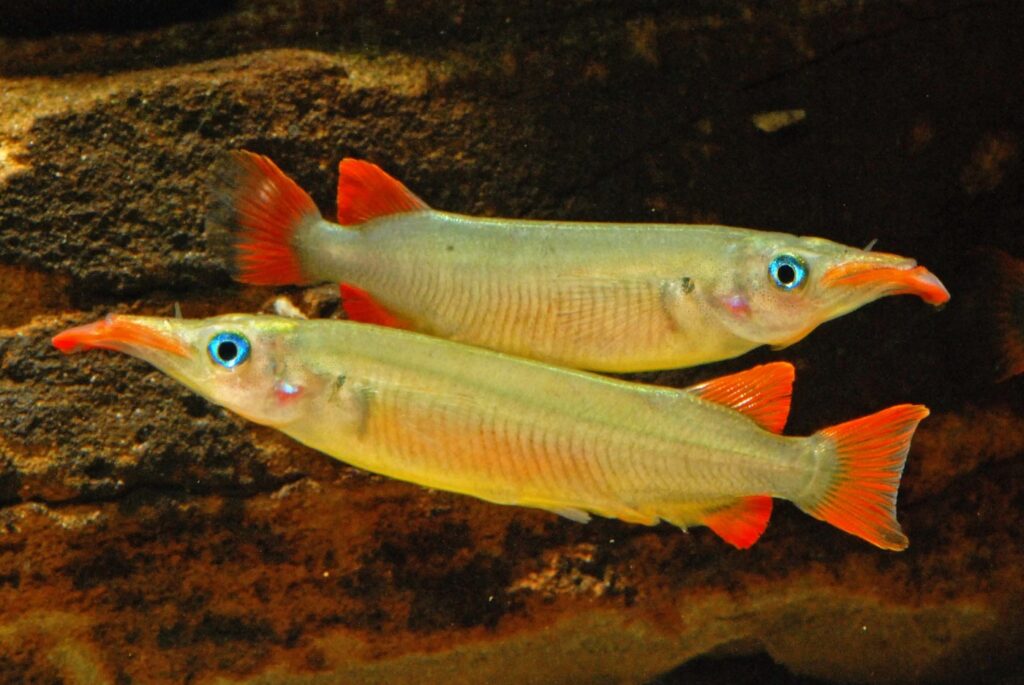
Viviparous halfbeaks (Zenarchopteridae)
16 species endemic in Sulawesi
Short description: Easily recognizable due to their peculiar body shape and elongated jaws. In nature, they stay in larger flocks; in the aquarium they are often territorial. Livebearing (with a possible exception in the case of Tondanichthys kottelati).
Distribution: In lakes and streams including hillstreams, most species in Central, South and South East Sulawesi.
Species kept in aquaria: Nomorhamphus liemi (common), some other Nomorhamphus species quite rarely (celebensis, eberardtii, rex… including populations with known origin but unclear taxonomy)
IUCN Red list evaluation: critically endangered: Tondanichthys kottelati (endemic to Lake Tondano); endangered: Nomorhamphus celebensis, N. lanceolatus, N. sagittarius; vulnerable: Dermogenys orientalis, Nomorhamphus towoetii; near threatened: Nomorhamphus kolonodalensis, N. liemi, N. megarrhamphus, N. weberi; least concern: Nomorhamphus rex; data deficient: Dermogenys vogti, Nomorhamphus brembachi, N. eberardtii, N. hageni; not evaluated: Nomorhamphus aenigma (described 2020)
Current status and threats: Most species are endemic to individual lakes or river systems, therefore their status depends on the conditions of their location. Further research is needed to confirm the distribution and status of each species.
Sulawesi Keepers note: In Germany, there is a Halfbeak Working Group focused on the cooperation of enthusiasts and scientists, the exchange of information and the long-term conservation of halfbeak populations.
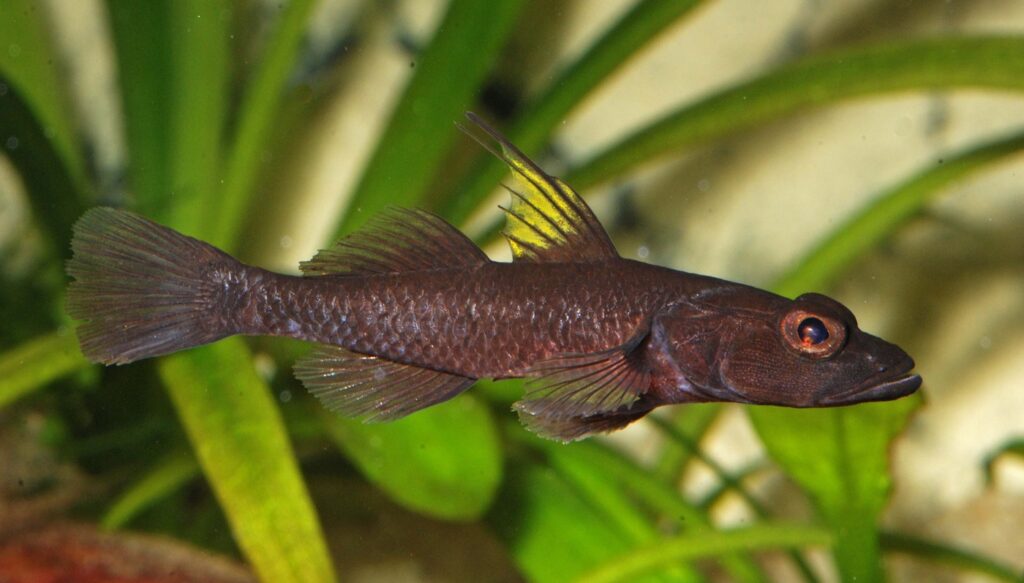
Gobies (Gobiidae)
11 species endemic in Sulawesi
Short description: Gobies are one of the most diverse families of fish with most species being marine or anadromous. The rivers of Sulawesi have a high number of anadromous species, but only pure freshwater species representing the genus Glossogobius or Mugilogobius are endemic. Small to medium-sized predatory fish, territorial, usually not very good swimmers, staying close to the substrate (bottom, rocks, plants).
Distribution: most species are endemic to lakes, few enter adjacent rivers
Species kept in aquaria: Glossogobius flavipinnis, Mugilogobius adeia, M. hitam (sometimes sold as M. amadi), M. latifrons, M. rexi, M. sarasinorum – all rare
IUCN Red list evaluation: critically endangered: Mugilogobius amadi (endemic to Lake Poso); endangered: Glossogobius mahalonensis, Mugilogobius adeia, M. latifrons, M. sarasinorum; near threatened: Glossogobius flavipinnis, G. intermedius, G. matanensis, Mugilogobius lepidotus, M. rexi, M. hitam
Current status and threats: Species endemic to Lake Matano are most threatened by the presence of the flowerhorn, an invasive cichlid that dominates the lake; the impact of this threat is not quantified, but it is evident. Flowerhorns are also spreading to other lakes of the Malili system (and are already present in Lake Poso, but in limited numbers). Mugilogobius amadi has not been recorded for over four decades and is possibly extinct.
Sulawesi Keepers note: Successful breeding of endemic gobies from Sulawesi in aquaria has not yet been achieved. Some species spawn easily, but the larvae are extremely tiny and no one has yet found a suitable way to feed and raise them. It is worth a try, given that the natural habitats of these gobies are highly threatened.
Markéta Rejlková

